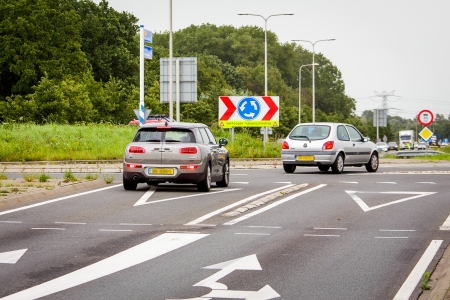Several SWOV reports and a DTV Consultants memo show that the safety benefits of a roundabout are greater when cyclists at bicycle tracks are not given right of way [12] [30] [31] [32]. In 2002, Dijkstra [12] calculated an estimated annual reduction of 52 to 73 inpatients[i], if cyclists were not given right of way at any roundabout with bicycle tracks. An additional factor is that roundabouts are the safest intersection type for cyclists anyway (also see the section How safe are roundabouts to cyclists? ).
Cyclists not having right of way implies that they should yield to motor vehicles on the legs of the roundabouts, cyclists having right of way implies that motor vehicles should yield to cyclists. In general, roundabouts are very safe intersections to cyclists (whether or not having right of way). There are two possible reasons why roundabouts with cyclist priority are less safe [12]. First, drivers could wrongly think they automatically have right of way over cyclists. Second, drivers wanting to enter a roundabout are focused on motorised traffic already on the roundabout, and they have a hard time needing to give right of way to cyclists on a bicycle track as well. Drivers would need to make (too) many observations in a short time, which would facilitate the overlooking of cyclists. Considering cyclist vulnerability in a crash with a motor vehicle (or the great difference in mass between cyclists and motor vehicles), this crash type often has serious consequences, for cyclists in particular.
Despite the conclusion that, on roundabouts with bicycle tracks, cyclists not having right of way are safer than cyclists who do, CROW recommends to create cyclist priority on these roundabouts in the urban area, but not outside the urban area [36]. This guideline is based on balancing safety, comfort and cyclist traffic flow.
[i] At the time of this study, the term inpatients was normally used in the Netherlands. From 2010 however, this term was abandoned as not all inpatients (as registered in BRON) proved to have been hospitalised or seriously injured.
